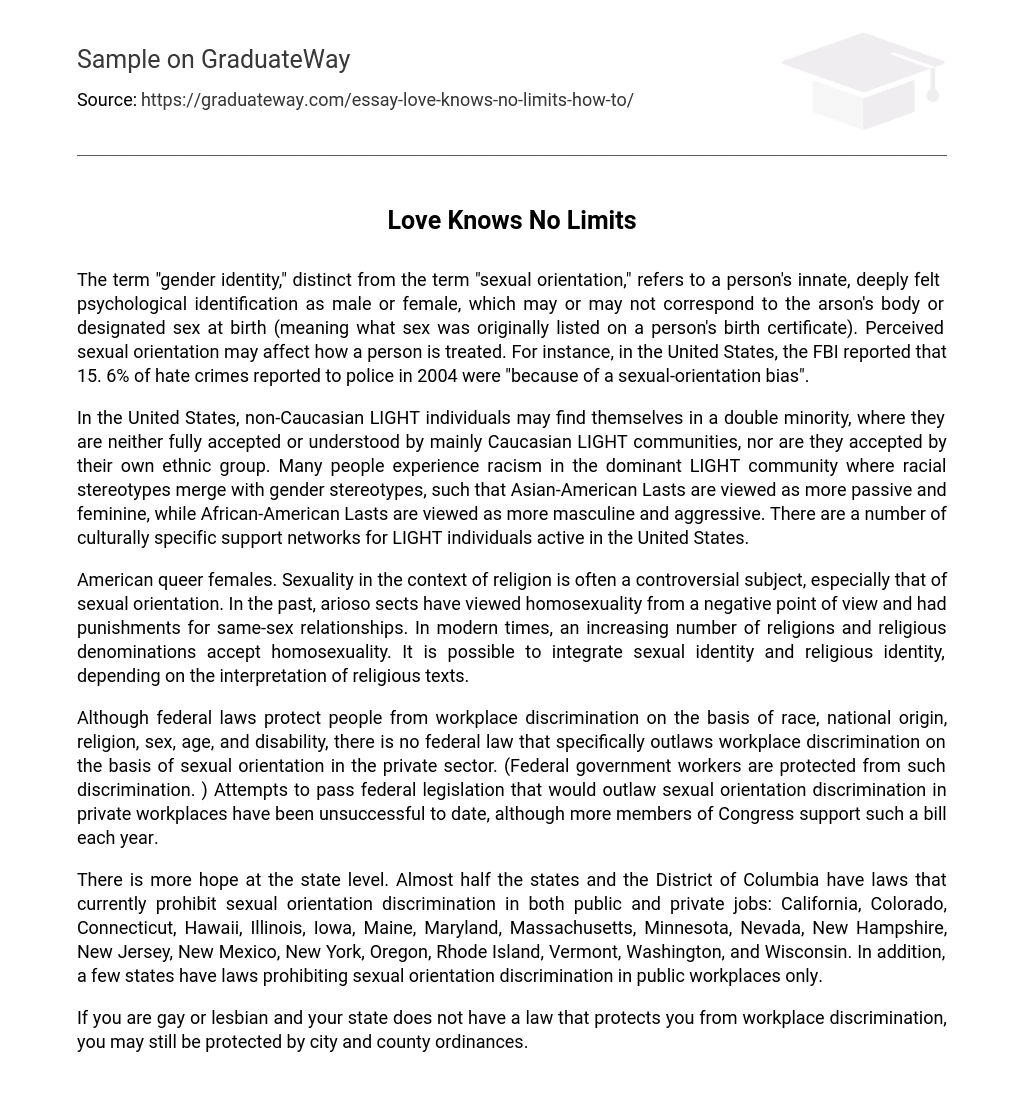The term “gender identity,” distinct from the term “sexual orientation,” refers to a person’s innate, deeply felt psychological identification as male or female, which may or may not correspond to the arson’s body or designated sex at birth (meaning what sex was originally listed on a person’s birth certificate). Perceived sexual orientation may affect how a person is treated. For instance, in the United States, the FBI reported that 15. 6% of hate crimes reported to police in 2004 were “because of a sexual-orientation bias”.
In the United States, non-Caucasian LIGHT individuals may find themselves in a double minority, where they are neither fully accepted or understood by mainly Caucasian LIGHT communities, nor are they accepted by their own ethnic group. Many people experience racism in the dominant LIGHT community where racial stereotypes merge with gender stereotypes, such that Asian-American Lasts are viewed as more passive and feminine, while African-American Lasts are viewed as more masculine and aggressive. There are a number of culturally specific support networks for LIGHT individuals active in the United States.
American queer females. Sexuality in the context of religion is often a controversial subject, especially that of sexual orientation. In the past, arioso sects have viewed homosexuality from a negative point of view and had punishments for same-sex relationships. In modern times, an increasing number of religions and religious denominations accept homosexuality. It is possible to integrate sexual identity and religious identity, depending on the interpretation of religious texts.
Although federal laws protect people from workplace discrimination on the basis of race, national origin, religion, sex, age, and disability, there is no federal law that specifically outlaws workplace discrimination on the basis of sexual orientation in the private sector. (Federal government workers are protected from such discrimination. ) Attempts to pass federal legislation that would outlaw sexual orientation discrimination in private workplaces have been unsuccessful to date, although more members of Congress support such a bill each year.
There is more hope at the state level. Almost half the states and the District of Columbia have laws that currently prohibit sexual orientation discrimination in both public and private jobs: California, Colorado, Connecticut, Hawaii, Illinois, Iowa, Maine, Maryland, Massachusetts, Minnesota, Nevada, New Hampshire, New Jersey, New Mexico, New York, Oregon, Rhode Island, Vermont, Washington, and Wisconsin. In addition, a few states have laws prohibiting sexual orientation discrimination in public workplaces only.
If you are gay or lesbian and your state does not have a law that protects you from workplace discrimination, you may still be protected by city and county ordinances. Many cities and counties prohibit discrimination on the basis of sexual orientation in at least some workplaces. Depending on which component of sexual orientation is being assessed and preferred, different conclusions can be drawn about the prevalence rate of homosexuality which has real world consequences.
Knowing how much of the population is made up of homosexual individuals’ influences how this population may be seen or treated by the public and government bodies. For example, if homosexual individual luaus constitute only 1 % of the general population they are politically easier to ignore than if they are known to be a constituency that surpasses most ethnic ad minority groups. If the number is relatively minor then it is difficult to argue for community based same sex orgasm and services, mass media inclusion of gay role models, or Gay/ Straight Alliances in schools.
For this reason, in the sass Bruce Volley, the chair of the Force (which is an organization that supports the LIGHT community) perpetuated a common myth that the prevalence of homosexuality is 10% for the whole population by averaging a 13% number for men and a 7% number for women. Volley generalized this finding and used it as part of the modern gay rights movement to convince politicians and the public that “we [gays and lesbians] are every. Inhere. Homophobia encompasses a range of negative attitudes and feelings toward homosexuality or people who are identified or perceived as being lesbian, gay, bisexual or transgender (LIGHT).
It can be expressed as antipathy, contempt, prejudice, aversion, or hatred and, may be based on irrational fear, or is sometimes related to religious beliefs. Homophobia is observable in critical and hostile behavior such as discrimination and violence on the basis of sexual orientations that are non-heterosexual. Learning about the dynamics of sexual orientation and evolving an appreciation of the differences and diversity in that field will help to deepen understanding of others, to change attitudes, and eventually, to make life better for people of all sexual orientations.





